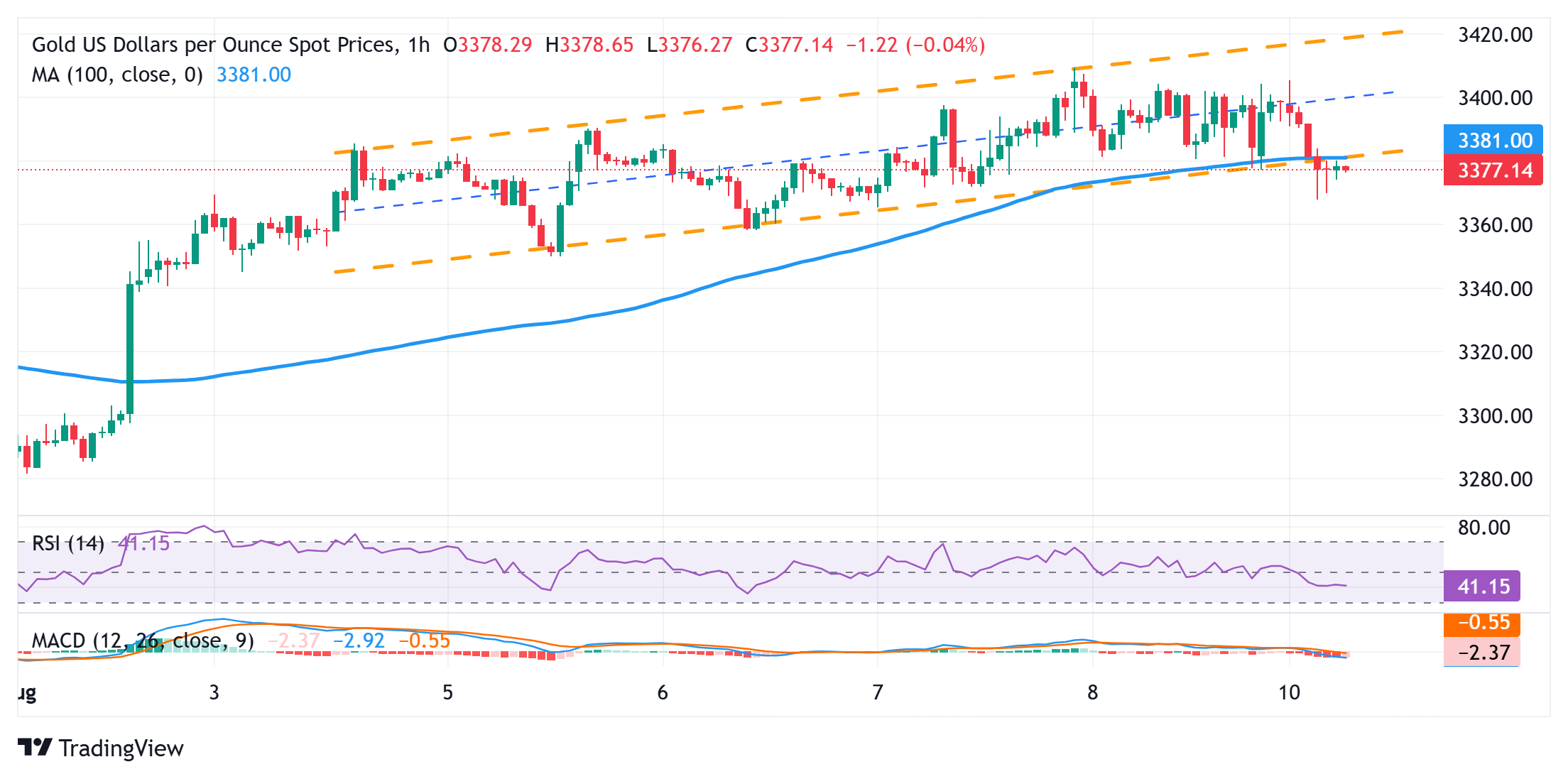Created
: 2025.08.11














![]() 2025.08.11 13:33
2025.08.11 13:33
Gold price (XAU/USD) continues with its struggle to find acceptance above the $3,400 mark and attracts heavy selling during the Asian session on Monday. The sharp intraday fall is sponsored by a positive risk tone, which tends to undermine demand for the traditional safe-haven bullion. However, a combination of factors holds back traders from placing aggressive bearish bets and assists the precious metal to rebound slightly from the $3,368-3,367 region.
Persistent trade-related uncertainties ahead of the looming US tariff deadline on China, which is due to expire on Tuesday, keep investors on edge. Moreover, bets that the Federal Reserve (Fed) will cut interest rates more than previously expected prompt fresh US Dollar (USD) and help limit losses for the non-yielding Gold price. Adding to this, nervousness heading into the US-Russia bilateral talks on Ukraine offers some support to the XAU/USD pair.

Monday's intraday downfall drags the Gold price below the $3,382 confluence - comprising the 100-hour Simple Moving Average (SMA) and the lower boundary of a short-term ascending channel. Furthermore, oscillators on the said chart have been gaining negative traction and back the case for a further depreciating move. That said, positive technical indicators on 4-hour/daily charts suggest that any subsequent slide is more likely to find decent support near the $3,353-3,350 area. A convincing break below, however, will be seen as a fresh trigger for bearish traders and makes the XAU/USD pair vulnerable to accelerate the slide towards the $3,315 intermediate support en route to the $3,300 round figure.
On the flip side, the $3,400 mark might continue to act as an immediate strong barrier and cap any attempted recovery. That said, some follow-through buying beyond last week's swing high, around the $3,409-3,410 area, would negate the negative outlook and lift the Gold price to the next relevant hurdle near the $3,422-3,423 area. The momentum could extend further towards the $3,434-3,435 strong horizontal barrier. A sustained strength beyond the latter should pave the way for a move towards challenging the all-time peak, around the $3,500 psychological mark touched in April.
In the world of financial jargon the two widely used terms "risk-on" and "risk off'' refer to the level of risk that investors are willing to stomach during the period referenced. In a "risk-on" market, investors are optimistic about the future and more willing to buy risky assets. In a "risk-off" market investors start to 'play it safe' because they are worried about the future, and therefore buy less risky assets that are more certain of bringing a return, even if it is relatively modest.
Typically, during periods of "risk-on", stock markets will rise, most commodities - except Gold - will also gain in value, since they benefit from a positive growth outlook. The currencies of nations that are heavy commodity exporters strengthen because of increased demand, and Cryptocurrencies rise. In a "risk-off" market, Bonds go up - especially major government Bonds - Gold shines, and safe-haven currencies such as the Japanese Yen, Swiss Franc and US Dollar all benefit.
The Australian Dollar (AUD), the Canadian Dollar (CAD), the New Zealand Dollar (NZD) and minor FX like the Ruble (RUB) and the South African Rand (ZAR), all tend to rise in markets that are "risk-on". This is because the economies of these currencies are heavily reliant on commodity exports for growth, and commodities tend to rise in price during risk-on periods. This is because investors foresee greater demand for raw materials in the future due to heightened economic activity.
The major currencies that tend to rise during periods of "risk-off" are the US Dollar (USD), the Japanese Yen (JPY) and the Swiss Franc (CHF). The US Dollar, because it is the world's reserve currency, and because in times of crisis investors buy US government debt, which is seen as safe because the largest economy in the world is unlikely to default. The Yen, from increased demand for Japanese government bonds, because a high proportion are held by domestic investors who are unlikely to dump them - even in a crisis. The Swiss Franc, because strict Swiss banking laws offer investors enhanced capital protection.
![]()
Created
: 2025.08.11
![]()
Last updated
: 2025.08.11

FXStreet is a forex information website, delivering market analysis and news articles 24/7.
It features a number of articles contributed by well-known analysts, in addition to the ones by its editorial team.
Founded in 2000 by Francesc Riverola, a Spanish economist, it has grown to become a world-renowned information website.
We hope you find this article useful. Any comments or suggestions will be greatly appreciated.
We are also looking for writers with extensive experience in forex and crypto to join us.
please contact us at [email protected].
Disclaimer:
All information and content provided on this website is provided for informational purposes only and is not intended to solicit any investment. Although all efforts are made in order to ensure that the information is correct, no guarantee is provided for the accuracy of any content on this website. Any decision made shall be the responsibility of the investor and Myforex does not take any responsibility whatsoever regarding the use of any information provided herein.
The content provided on this website belongs to Myforex and, where stated, the relevant licensors. All rights are reserved by Myforex and the relevant licensors, and no content of this website, whether in full or in part, shall be copied or displayed elsewhere without the explicit written permission of the relevant copyright holder. If you wish to use any part of the content provided on this website, please ensure that you contact Myforex.
Myforex uses cookies to improve the convenience and functionality of this website. This website may include cookies not only by us but also by third parties (advertisers, log analysts, etc.) for the purpose of tracking the activities of users. Cookie policy